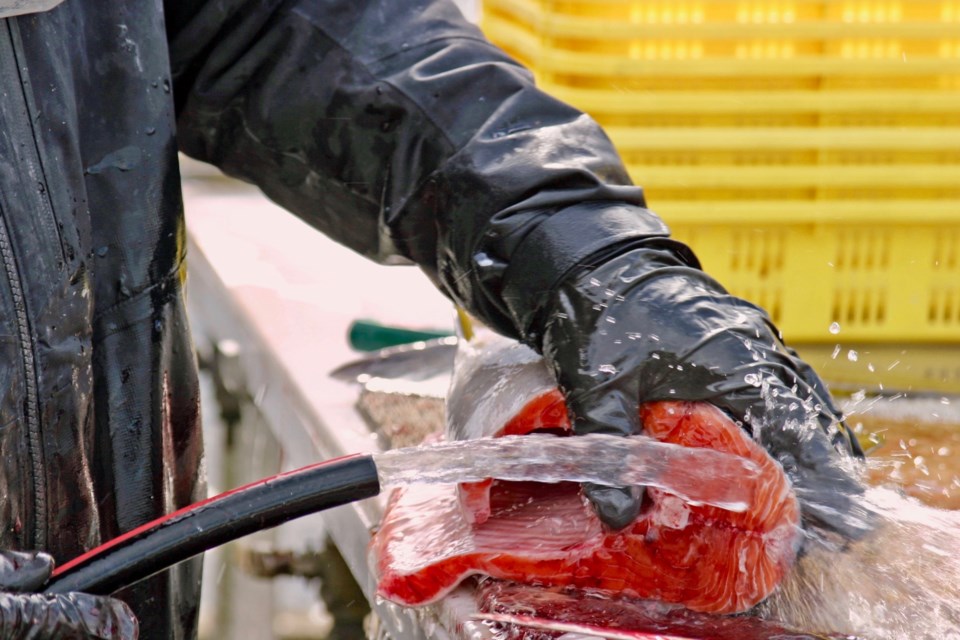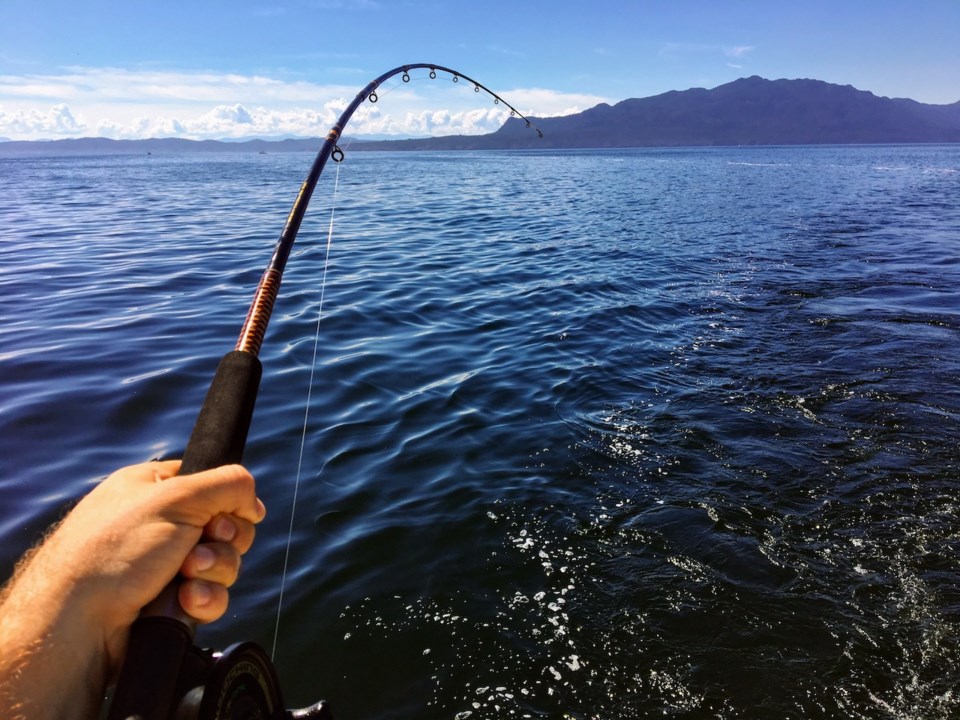There won't be chinook salmon brought home from the waters around Squamish this summer.
Fisheries and Oceans Canada (DFO) and MP Terry Beech, parliamentary secretary to the minister of fisheries, announced that chinook retention has been closed for the majority of the South Coast and Vancouver Island from Port Hardy south to Victoria from April 1 to July 15 or Aug. 1, depending on the area.
After that date until August 31, one chinook between 62 and 80 centimetres can be retained.
In an unprecedented move, an extensive area that includes portions of Howe Sound, the Southern Gulf Islands, Vancouver Harbour and the entire Fraser River mouth has been deemed a no-chinook fishing zone, even for catch and release, from April 1 to Sept. 1.
Jason Assonitis' voice shakes with anger and frustration when asked how he feels about the Department of Fisheries and Oceans regulations.
"Basically, the entire peak season has now been closed, not only to the retention of chinook, but also now been closed to targeting them — catch and release them, said Assonitis, who owns Bon Chovy Fishing Charters.
"This has basically destroyed not only the charter industry, but it has also destroyed the sportfishing businesses that rely on the chinook fishery, and it also destroys the integrity of fishing values and conservation values that are passed on from generation to generation."
Dave Brown, a sport fisherman on the Sea to Sky Fisheries Roundtable, says DFO isn't addressing what is really causing impacts on troubled chinook stocks.
"It is not acceptable, there is no recovery plan, and it is devastating for people who enjoy access to the public fishery.
Brown points to 23 chinook gillnet openings that have taken place this year on the lower Fraser River as a sign that conservation of chinook is not the DFO's main focus.
He also points to what he says is a lack of action on seals and sea lions impacting chinook numbers.
"It is now clear that the Department of Fisheries and Oceans and the Liberal government is making a political sacrifice in order to appease different stakeholders, and this has nothing to do with science," Assonitis said, adding he sees it as a bureaucratic maneuver.
Avid angler Perri Domm echoes Brown and Assonitis. Domm has guided and fished out of Tofino for 12 years and fished in Vancouver-area saltwater for 30 years on his 24-foot Grady-White.
He says these regulations "could not be worse."
DFO could be doing more to increase fish stocks and address gravel extraction, Domm says. They organization could also look into exploding seal populations, habitat destruction and agricultural runoff, he continued.
"It certainly does not fall on the single, small, little guy user," Domm says.
"We are just the simple, easy targets that look good but actually do nothing to improve the situation."
Sea to Sky sports fishers plan a rally about this issue on July 6 outside the DFO office in Vancouver.

Sports fishery organizations weigh in
The Sport Fishing Institute of B.C. was quick to chime in the day the chinook measures were announced.
"Appreciating that there are abundant chinook stocks, both wild and hatchery, from other systems in our waters now and that the carefully developed Sport Fishing Advisory Board (SFAB) proposals identified times, areas and limits that reduced or eliminated pressure on Fraser River stocks of concerns, it is unclear why the health and well-being of communities and citizens is being forgone," read the institute's news release.
In an open letter to Fisheries Minister Bernadette Jordan, the BC Wildlife Federation called the measures "some of the most draconian fishing measures in recorded history."
"There is no transparency, no accountability, and no trust while there are fewer and fewer salmon. DFO is a failed agency that no longer manages for the well-being of fish or the public interest. Instead, DFO is now focussed exclusively on cutting back the public fishery to give the appearance it is doing something while managing for political benefit," reads the BC Wildlife Federation letter, signed by its president Bill Bosch.
"This management approach is unraveling the social fabric of the public fishery, dividing users and communities and bankrupting service providers."
DFO on its regulations
The Department of Fisheries and Oceans says declining chinook stocks demanded strong action.
"Southern BC Chinook populations face a number of potential challenges, including declining numbers returning to spawn, reduced survival and productivity, habitat pressures and a changing climate," reads an emailed statement from the DFO.
The DFO points out that in November of 2018, the Committee on the Status of Endangered Wildlife in Canada (COSEWIC) evaluated seven Fraser chinook populations as endangered, four as threatened and one as special concern.
"We urgently need to address these declines, as well as the changes to marine life and ecosystems that are directly affecting salmon and our coastal communities," reads the statement.
In answer to Brown and Assonitis’ assertion that fishers can avoid stocks of concern and continue to fish for those still in abundance, the DFO said, "It is true that endangered, threatened, and special concern Fraser chinook co-migrate with more abundant chinook stocks in marine areas and often represent a small proportion of the total catch. However, given the current low productivity and low numbers of at-risk chinook, and to limit further declines of these populations, and in order to allow most fish to reach their spawning areas, fisheries management measures which realize very low fishery mortalities are required."
The fishery management measures are intended to reduce fishery mortalities to near five percent.
"Given current population sizes of at-risk Fraser Chinook, this would allow for very low fishery mortalities in the range of several hundred to just over 1,000 chinook for each group of at-risk Fraser chinook for all fisheries in Canada, including First Nations, recreational and commercial," the statement continued.
"Conservation is our first priority in the management of the salmon fishery, followed by First Nations food, social and ceremonial fisheries. These are difficult decisions that impact a wide range of communities. It is important that we make decisions that will ultimately lead to improved salmon populations so that we have healthy and abundant salmon runs in the future that will support Indigenous, commercial and recreational fisheries."
According to the DFO, its staff will be working with the Integrated Harvest Planning Committee, which has representatives from each fishing sector, to implement targeted fisheries in areas where at-risk Fraser River chinook should not be encountered.
The DFO is also considering whether to expand the retention of hatchery-origin marked chinook and mass-marking of hatchery chinook production.
There are several issues that DFO says it is considering in making this decision.
Mass-marking of all hatchery fish would require Canada to significantly adapt fishery monitoring and stock assessment programs to maintain information on wild Chinook and support Pacific Salmon Treaty obligations, according to the statement sent to The Chief.
Marking significant numbers of hatchery-origin chinook would be expensive and in some areas would be logistically challenging, DFO says.
Producing additional hatchery-origin chinook to support fisheries must be carefully planned to ensure the carrying capacity of natural systems to support salmon and control potential competitive interactions between hatchery and wild salmon, the DFO says.
It also must be done in a way to ensure that the genetic diversity of wild origin salmon is maintained, and that marked fish do not adversely impact wild unmarked stocks of conservation concern.
The department is conducting a pilot project to mark Conuma River Hatchery chinook, off the coast of Vancouver Island, in conjunction with a project exploring the application of genetic tools over the next three years.
Sea to Sky MP response
MP Patrick Weiler says he met with Sea to Sky sports fishers before the recent DFO decisions and was set to meet with them again this week.
"I certainly understand the impact to the recreational fishing industry and I definitely sympathize with them and those businesses and communities that rely on this. It does limit salmon harvesting opportunities in a very significant way," he said, adding that the long-term goal of the closures is to sustain the fisheries.
"I know the proposals made by the Sports Fishery Advisory Board were very well thought out and several of those were taking into account with the decisions that were made for the chinook fishery," he said, noting, in particular, the pilot project areas of retention.
The Big Bar massive landslide in the Fraser River has exacerbated the stress on the Fraser chinook stocks, he noted.
As does loss of salmon-bearing habitat and the impacts of climate change.
"In many ways, it is a perfect storm. So the decision that has been made has been done with this in mind, knowing that even adding additional stress that really puts these stocks of concern in a really, really difficult position," he said.
Weiler said while recreational fishers say they would only have a 1% impact on the stocks, 250,000 licenses are held for the Pacific Region, which includes our waters.
"When you look in terms of the absolute numbers, it is a significant impact. And even when you have very experienced anglers who make up this industry, by and large, there still is the risk of mortality with catch and release and identifying the right fish that they are taking out."
On not even allowing catch and release, Weiler said that mortality is an issue and that environmental and First Nations groups have expressed concern about the practice.
Weiler rejected the suggestion that the closures weren't based on science, but on politics.
"That is one of the reasons it has taken a little bit longer this year to come out with the decisions on the fisheries because it was really important to take into account how effective the measures were last year and to make sure that what is being proposed this year is based on the evidence that DFO has at its disposal."
Weiler acknowledged that DFO could be "more transparent with their science."
"I know that there are some positive changes that have been made on this in the last few years, but it certainly has a long way to go and I continue to... make that case to the minister and the parliamentary secretary for fisheries and oceans."
He said that committees have been set up to include stakeholders.
"But I do think it is important that DFO make more strides to be transparent."
Weiler touted the more than $100 million invested in improving stock assessment in 2018 and funds allocated to implement Fisheries Act changes.
"These things are really important so we have a better sense of the evidence so we can make the best decisions on the basis of them."




